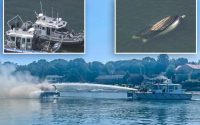Possible cause IDed in death of lawyer Dana Hyde during jet turbulence
A prominent DC attorney aboard a corporate jet that experienced severe turbulence died last week — and officials said stability issues are likely to blame in the accident.
Dana Hyde, 55 was identified by Connecticut State Police after a plane she was on made an emergency landing Friday afternoon at Bradley International Airport, near Hartford.
The National Transportation Safety Board told The Post in a statement that its “investigators are now looking at a reported trim issue that occurred prior to the inflight upset.”
Hyde, of Cabin John, Maryland, was injured during the severe turbulence, and pronounced dead shortly at Hartford’s Saint Francis Medical Center following the emergency landing, police said.

Hyde was among five people aboard the flight, which originated in Keene, New Hampshire, and was meant to land in Leesburg, Virginia when it started to experience severe turbulence over New England.
Hyde served as a counsel on the 9/11 commission and as the association director of general government programs of the Office of Management and Budget under the Obama administration, according to her LinkedIn.
The agency will “analyze information from the flight data recorder, cockpit voice recorder and other sources of information like weather data” to further determine the cause, it said in a statement. A preliminary report is expected in a few weeks.
The Bombardier Challenger 300 aircraft on which she died is owned by the Missouri-based internet service provider Conexon, the company said. The two crew members and two other passengers are being interviewed by investigators, who did not state if the four others had injuries, according to the NTSB.
Fatalities due to turbulence are very rare, but last year the Federal Aviation Administrator warned pilots of the same Bombardier model to be particularly careful due to previously trim issues that affected stability, according to Fox News.
Trim refers to adjustments that are made to an airplane’s control surfaces to ensure it is stable and level in flight.
The FAA had documented multiple instances where the plane nose-dived as pilots tried to gain altitude and said in some cases pilots should make more-thorough inspections of the pitch trim, which is a secondary flight control.
With Post wires



